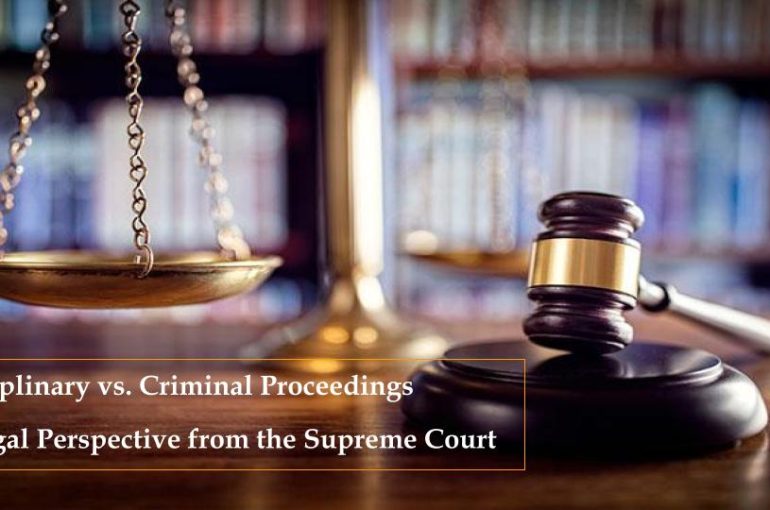Disciplinary vs. Criminal Proceedings: A Legal Perspective from the Supreme Court
Introduction
The Supreme Court of India recently adjudicated a significant case in Airports Authority of India v. Pradip Kumar Banerjee (2025 INSC 149), dealing with corruption charges against a public official. This case involved multiple layers of judicial review, including criminal proceedings, departmental disciplinary actions, and writ petitions. The Court’s decision reaffirms important legal principles concerning disciplinary inquiries, standard of proof, and the distinction between criminal trials and departmental proceedings.
Case Background
The Respondent, Pradip Kumar Banerjee, was employed as an Assistant Engineer (Civil) with the Airports Authority of India (AAI). He was arrested along with a Junior Engineer under charges of corruption under Sections 7[1], 13(2)[2] read with Section 13(1)(d) of the Prevention of Corruption Act, 1988, and Section 34[3] of the Indian Penal Code, 1860, for allegedly demanding and accepting bribes.
The Special Judge, CBI Court, Alipore, convicted Banerjee on December 10, 1999. However, his co-accused was acquitted. Subsequently, the AAI dismissed Banerjee from service, relying on the CBI Court’s conviction.
Chronology of Legal Proceedings
1. Criminal Appeal Before the High Court
Banerjee challenged his conviction before the High Court of Calcutta. On July 16, 2004, the High Court allowed the appeal, acquitting him by granting the benefit of doubt due to insufficient evidence.
2. Departmental Disciplinary Action and Writ Petitions
Following the acquittal, Banerjee sought reinstatement. However, AAI refused, arguing that his acquittal was not an ‘Honorable Acquittal.’ The matter led to multiple rounds of litigation:
- The High Court initially directed AAI to reconsider the dismissal in light of the acquittal (February 5, 2001).
- AAI, after reconsideration, ordered a fresh disciplinary inquiry against Banerjee (March 24, 2005).
- Banerjee challenged this decision in a writ petition, leading to a High Court ruling in his favor (February 23, 2007).
- AAI appealed the decision, and the Division Bench of the High Court reversed the Single Judge’s ruling, permitting the disciplinary inquiry (August 6, 2007).
3. Disciplinary Inquiry and Final Dismissal
The disciplinary inquiry concluded that Banerjee was guilty of misconduct. He was dismissed from service. His departmental appeal was rejected by a sub-committee formed as per the High Court’s directive.
4. Final Writ Appeal Before the High Court
Banerjee challenged his dismissal again, and the Single Judge dismissed his petition (June 29, 2011). However, in an intra-court appeal, the Division Bench overturned this decision (March 1, 2012), leading to the Supreme Court challenge by AAI.
Supreme Court’s Ruling
The Supreme Court set aside the High Court’s Division Bench ruling, restoring the decision of the Single Judge and the dismissal order against Banerjee. Key observations of the Supreme Court included:
1. Standard of Proof in Disciplinary Proceedings
- The Court reaffirmed that disciplinary proceedings require proof based on the ‘preponderance of probabilities’ unlike criminal trials, which require proof ‘beyond reasonable doubt.’
- Since Banerjee’s acquittal was based on a lack of sufficient evidence rather than a positive finding of innocence, it did not preclude departmental action.
2. Non-Examination of the Complainant
The High Court had erred in holding that the non-examination of the original complainant was fatal to the disciplinary proceedings. The Supreme Court held that corroborative evidence, including testimony from other officials, was sufficient to establish guilt in a departmental inquiry.
3. Distinction Between Criminal and Departmental Proceedings
The Court reiterated that disciplinary inquiries serve a different purpose than criminal trials. The findings of the disciplinary inquiry were based on material evidence, including testimonies of the trap-laying officer and independent witnesses.
4. Prior Judgment’s Finality
The Supreme Court pointed out that in 2007, the Division Bench of the High Court had already held that Banerjee’s acquittal was not honorable and that departmental proceedings were justified. It was affirmed in 2008 by dismissing Banerjee’s SLP. The Division Bench’s decision in 2012, which contradicted the 2007 ruling, was therefore unsustainable.
Key Takeaways from the Judgment
- Departmental and Criminal Proceedings Are Independent – The judgment reinforces the well-established principle that acquittal in a criminal case does not automatically absolve an employee in a departmental inquiry.
- Preponderance of Probabilities Suffices – The disciplinary authority does not need to establish guilt beyond a reasonable doubt; a lower threshold of proof applies.
- Prior Court Decisions Carry Weight – Once a matter has been decided and affirmed by the Supreme Court, subsequent contradictory rulings by lower courts are not tenable.
- Role of Writ Jurisdiction in Disciplinary Matters – Courts exercising writ jurisdiction should not re-evaluate evidence unless procedural irregularities exist.
Conclusion
The Supreme Court’s decision in Airports Authority of India v. Pradip Kumar Banerjee serves as a landmark ruling on the interplay between criminal trials and disciplinary inquiries. By upholding the dismissal order, the Court reaffirmed the principle that disciplinary authorities can act independently of criminal court findings, provided the inquiry is fair and follows due process. This ruling strengthens the jurisprudence on employer disciplinary powers and maintains the integrity of public institutions against corruption.
Shikha Pandey
Associate
The India Lawyer & Allied Services
“Please log on to our YouTube channel, The Indian Lawyer Legal Tips, to learn about various aspects of the law. Our latest video, titled ‘Law on Ancestral Property,’ can be viewed at the link below:”
[1]https://www.indiacode.nic.in/show-data?abv=CEN&statehandle=123456789/1362&actid=AC_CEN_26_36_00001_198849_1517807318890§ionId=43718§ionno=7&orderno=7&orgactid=AC_CEN_26_36_00001_198849_1517807318890
[2]https://www.indiacode.nic.in/show-data?abv=CEN&statehandle=123456789/1362&actid=AC_CEN_26_36_00001_198849_1517807318890§ionId=43725§ionno=13&orderno=14&orgactid=AC_CEN_26_36_00001_198849_1517807318890
[3] Acts done by several persons in furtherance of common intention.—When a criminal act is done by several persons in furtherance of the common intention of all, each of such persons is liable for that act in the same manner as if it were done by him alone.





































Leave a Reply